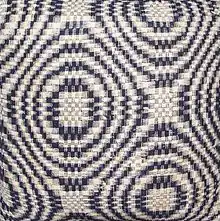Linsey-woolsey
Linsey-woolsey (less often, woolsey-linsey or in Scots, wincey) is a coarse twill or plain-woven fabric woven with a linen warp and a woollen weft. Similar fabrics woven with a cotton warp and woollen weft in Colonial America were also called linsey-woolsey or wincey.[1][2] The name derives from a combination of lin (an archaic word for flax, whence "linen") and wool. This textile has been known since ancient times; known as shatnez (שַׁעַטְנֵז) in Hebrew, the Torah and hence Jewish law explicitly forbade wearing it.[3]

History
Mentions of a linsey-woolsey appear in late medieval sources in the Netherlands, as well as in other north-western European areas in the proceeding couple hundred years. In French, it went by "tiretaine", Danish "thirumtej", and by other names in other languages. These names were anglicised as "turtein" or "tartan" (not to be confused with tartan patterns).[4] Hemp would also have been used together with the linen in warp yarns at this time.
The coarse fabric called stuff woven at Kidderminster from the 17th century, originally a wool fabric, may have been of linsey-woolsey construction later on. Linsey-woolsey was an important fabric in the Colonial America due to the relative scarcity of wool in the colonies.[2] Many sources[5] say it was used for whole-cloth quilts, and when parts of the quilt wore out the remains would be cut up and pieced into patchwork quilts. Some sources dispute this[6] and say that the material was too rough and would have been used instead for clothing and occasionally for light blankets. It was also used as a ground fabric for needlepoint.
Linsey-woolsey was valued for its warmth, durability, and cheapness, but not for its looks.
Linsey-woolsey is also sometimes used to refer to 18th century woven coverlets or bed coverings made with a linen warp and woollen weft. The term is sometimes incorrectly applied to glazed textiles.[7]
Linsey-woolsey continues to be woven today in small quantities for historical recreation and Colonial period decorating uses.
Cultural references
- Mark Twain in his 1884 novel, The Adventures of Huckleberry Finn "The women had on sun-bonnets; and some had linsey-woolsey frocks,"
- Lucy Maud Montgomery uses the term "wincey" six times in Anne of Green Gables:[8] "a very ugly dress of yellowish gray wincey".
- Robert Louis Stevenson in his 1887 essay "Talk and Talkers," part of his collection of essays entitled Memories and Portraits "Last and chief, while literature, gagged with linsey-woolsey, can only deal with a fraction of the life of man,"
- Compton Mackenzie creates a minor character called Colonel Lindsay-Woolsey in his 1941 comedy novel The Monarch of the Glen.
- In Patrick Dennis's 1955 comic novel Auntie Mame Lindsay Woolsey is Mame Dennis's publisher friend.
- In the 1976 film The Outlaw Josey Wales, Josey's injured sidekick, Jamie (Sam Bottoms), refers to his father's embarrassing ability to sew ornate designs on his otherwise drab linsey-woolsey shirt.
- Washington Irving in his 1820 short story, The Legend of Sleepy Hollow, "a quantity of linsey-woolsey just from the loom."
- Harriet Jacobs in her autobiography Incidents in the Life of a Slave Girl, mentions "I have a vivid recollection of the linsey-woolsey dress given to me every winter by Mrs. Flint. How I hated it! It was one of the badges of slavery."
- Elihu Burritt in Walks in the Black Country and its Green Border-Land: "Here I saw the greatest contrast that I ever witnessed in England—Nature in linsey-woolsey petticoat and Nature in her court-dress"
- In John O'Hara's novel OURSELVES TO KNOW (London: The Cresset Press, 1960), it reads: "The man in the linsey-woolsey cassock got to his feet and blessed the hour" (p. 323).
Notes
- American Heritage Dictionary of the English Language, Fourth Edition, cited at FreeDictionary.com, retrieved 22 June 2007, and Random House Dictionary, via retrieved 25 June 2007
- Baumgarten, Linda: What Clothes Reveal: The Language of Clothing in Colonial and Federal America, Yale University Press, 2002. ISBN 0-300-09580-5, page 96
- "A garment of a Shaatnez mixture shall not come upon you" (Leviticus 19:19); "Do not wear Shaatnez — wool and linen together" (Deuteronomy 22:11).
- Kerridge, Eric (1985). Textile manufactures in early modern England. Internet Archive. Manchester, UK ; Dover, N.H. : Manchester University Press. ISBN 978-0-7190-1767-4.
- See Linsey-Woolsey at Quilt.com, retrieved 22 June 2007
- See for example Historic Textile Research & Articles Archived 2007-07-26 at the Wayback Machine, retrieved 22 June 2007
- Linsey-woolsey compared to glazed fabrics in antique quits Archived 2008-05-09 at the Wayback Machine
- Random House Dictionary, via retrieved 25 June 2007
Further reading
- Tozer, Jane and Sarah Levitt, Fabric of Society: A Century of People and their Clothes 1770-1870, Laura Ashley Press, ISBN 0-9508913-0-4


.svg.png.webp)